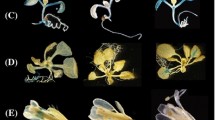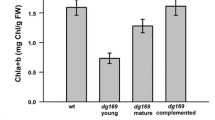Abstract
4-Hydroxybenzoate polyprenyl diphosphate transferase (4HPT) is the key enzyme that transfers the prenyl side chain to the benzoquione frame in ubiquinone (UQ) biosynthesis. The Arabidopsis AtPPT1 cDNA encoding 4HPT was cloned by reverse transcription-polymerase chain reaction (RT-PCR) based on the information of the Arabidopsis genomic sequence, and the function of the gene was determined. Heterologous expression of the AtPPT1 gene enabled restoration of the respiratory ability and UQ synthesis in a yeast mutant that was defective in 4HPT activity. The mitochondrial fraction that was prepared from the yeast mutant, which expressed the AtPPT1 gene, exhibited 4HPT enzymatic activity with geranyl diphosphate (GPP) as the prenyl substrate. This indicated that the AtPPT1 gene encodes active 4HPT with a broad substrate specificity in terms of the prenyl donor. The AtPPT1 mRNA was predominantly expressed in the flower cluster, and the green fluorescent protein (GFP) fused with the signal peptide of AtPPT1 was translocated into the mitochondria. T-DNA insertion mutation that disrupts the AtPPT1 gene in Arabidopsis resulted in the arrest of embryo development at an early stage of zygotic embryogenesis. These results demonstrate that the AtPPT1 gene involved in the biosynthesis of mitochondrial UQ plays an essential role in embryo development in Arabidopsis.
Similar content being viewed by others
References
Ashby, M. N., Kutsunai, S. Y., Ackerman, S., Tzagolo., A. and Edwards, P. A. 1992. COQ2 is a candidate for the structural gene encoding para-hydroxybenzoate:polyprenyltransferase. J. Biol. Chem. 267:4128–4136.
Avelange-Macherel, M. H. and Joyard, J. 1998. Cloning and functional expression of AtCOQ3, the Arabidopsis homologue of the yeast COQ3 gene, encoding a methyltransferase from plant mitochondria involved in ubiquinone biosynthesis. Plant J. 14:203–213.
Bader, M., Muse, W., Ballou, D. P., Gassner, C. and Bardwell, J. C. 1999. Oxidative protein folding is driven by the electron transport system. Cell 98:217–227.
Clough, S. J. and Bent, A. F. 1998. Floral dip:a simplified method for Agrobacterium-mediated transformation of Arabidopsis thaliana. Plant J. 16:735–743.
Collins, M. D. and Jones, D. 1981. Distribution of isoprenoid quinone structural types in bacteria and their taxonomic implications. Microbiol. Rev. 45:316–354.
Ernster, L. and Dallner, G. 1995. Biochemical, physiological and medical aspects of ubiquinone function. Biochim. Biophys. Acta 1271:195–204.
Ewbank, J. J., Barnes, T. M., Lakowski, B., Lussier, M., Bussey, H. and Hekimi, S. 1997. Structural and functional conservation of the Caenorhabditis elegans timing gene clk-1. Science 275:980–983.
Frei, B., Kim, M. C. and Ames, B. N. 1990. Ubiquinol-10 is an effective lipid-soluble antioxidant at physiological concentrations. Proc. Natl. Acad. Sci. USA. 87:4879–4883.
Grunler, J., Ericsson, J. and Dallner, G. 1994. Branch-point reactions in the biosynthesis of cholesterol, dolichol, ubiquinone and prenylated proteins. Biochim. Biophys. Acta 1212: 259–277.
Hihi, A. K., Gao, Y. and Hekimi, S. 2002. Ubiquinone is necessary for Caenorhabditis elegans development at mitochondrial and non-mitochondrial sites. J. Biol. Chem. 277: 2202–2206.
Hirooka, K., Bamba, T., Fukusaki, E. and Kobayashi, A. 2003. Cloning and kinetic characterization of Arabidopsis thaliana solanesyl diphosphate synthase. Biochem. J. 370: 679–686.
Holland, P. M., Abramson, R. D., Watson, R. and Gelfand, D. H. 1991. Detection of speci c polymerase chain reaction product by utilizing the 5 0–3 0 exonuclease activity of Thermus aquaticus DNA polymerase. Proc. Natl. Acad. Sci. USA. 88: 7276–7280.
Huang, J., Struck, F., Matzinger, D. F. and Levings, C. S. 3rd. 1994. Flower-enhanced expression of a nuclear-encoded mitochondrial respiratory protein is associated with changes in mitochondrion number. Plant Cell 3:439–448.
Kawamukai, M. 2002. Biosynthesis, bioproduction and novel roles of ubiquinone. J. Biosci. Bioeng. 94:511–517.
Lange, B. M. and Ghassemian, M. 2003. Genome organization in Arabidopsis thaliana:a survey for genes involved in isoprenoid and chlorophyll metabolism. Plant Mol. Biol. 51:925–948.
Levavasseur, F., Miyadera, H., Sirois, J., Tremblay, M. L., Kita, K., Shoubridge, E. and Hekimi, S. 2001. Ubiquinone is necessary for mouse embryonic development but is not essential for mitochondrial respiration. J. Biol. Chem. 276: 46160–46164.
Lutke-Brinkhaus, F., Liedvogel, B. and Kleinig, H. 1984. On the biosynthesis of ubiquinones in plant mitochondria. Eur. J. Biochem. 141:537–541.
Meganathan, R. 2001. Ubiquinone biosynthesis in microorganisms. FEMS Microbiol Lett. 203:131–139.
McKinney, E. C., Ali, N., Traut, A., Feldmann, K. A., Belostotsky, D. A., McDowell, J. M. and Meagher, R. B. 1995. Sequence-based identi cation of T-DNA insertion mutations in Arabidopsis:actin mutants act2–1 and act4–1. Plant J. 8: 613–622.
Melzer, M. and Heide, L. 1994. Characterization of polyprenyldiphosphate:4-hydroxybenzoate polyprenyltransferase from E. coli. Biochim. Biophys. Acta 1212:93–102.
Nakai, D., Yuasa, S., Takahashi, M., Shimizu, T., Asaumi, S., Isono, K., Takao, T., Suzuki, Y., Kuroyanagi, H., Hirokawa, K., Koseki, H. and Shirsawa, T. 2001. Mouse homologue of coq7 /clk-1, longevity gene in Caenorhabditis elegans, is essential for coenzyme Q synthesis, maintenance of mitochondrial integrity, and neurogenesis. Biochem. Biophys. Res. Commun. 289:463–471.
Okada, K., Kainou, T., Matsuda, H. and Kawamukai, M. 1998. Biological signifcance of the side chain length of ubiquinone in Saccharomyces cerevisiae. FEBS Lett. 431:241–244.
Okada, K., Saito, T., Nakagawa, T., Kawamukai, M. and Kamiya, Y. 2000. Five geranylgeranyl diphosphate synthases expressed in di. erent organs are localized into three subcellular compartments in Arabidopsis. Plant Physiol. 122:1045–1056.
Okada, K., Suzuki, K., Kamiya, Y., Zhu, X., Fujisaki, S., Nishimura, Y., Nishino, T., Nakagawa, T., Kawamukai, M. and Matsuda, H. 1996. Polyprenyl diphosphate synthase essentially de nes the length of the side chain of ubiquinone. Biochim. Biophys. Acta 1302:217–223.
Rentsch, D., Laloi, M., Rouhara, I., Schmelzer, E., Delrot, S. and Frommer, W. B. 1995. NTR1 encodes a high a. nity oligopeptide transporter in Arabidopsis. FEBS Lett. 370:264–268.
Rodriguez-Aguilera, J. C., Asencio, C., Ruiz-Ferrer, M., Vela, J. and Navas, P. 2003. Caenorhabditis elegans ubiquinone biosynthesis genes. Biofactors 18:2370–244. (Review.)
Saiki, R., Ogiyama, Y., Kainou, T., Nishi, T., Matsuda, H. and Kawamukai, M. 2003. Pleiotropic phenotypes of fission yeast defective in ubiquinone-10 production. A study from the abc1Sp (coq8Sp )mutant. Biofactors 18:229–235.
Sambrook, J., Fritsch, E. F. and Maniatis, T. 1989. Molecular Cloning:A Laboratory Manual. Cold Spring Harbor, Cold Spring Harbor Laboratory, New York.
Suzuki, K., Ueda, M., Yuasa, M., Nakagawa, T., Kawamukai, M. and Matsuda, H. 1994. Evidence that E. coli ubiA product is a functional homolog of yeast COQ2, and the regulation of ubiA gene expression. Biosci. Biotechnol. Biochem. 58: 1814–1819.
Swiezewska, E., Dallner, G., Andersson, B. and Ernster, L. 1993. Biosynthesis of ubiquinone and plastoquinone in the endoplasmic reticulum-Golgi membranes of spinach leaves. J. Biol. Chem. 268:1494–1499.
Tsugeki, R., Kochieva, E. Z. and Fedoro., N. V. 1996. A transposon insertion in the Arabidopsis SSR16 gene causes an embryo-defective lethal mutation. Plant J. 10:479–489.
Uchida, N., Suzuki, K., Saiki, R., Kainou, T., Tanaka, K., Matsuda, H. and Kawamukai, M. 2000. Phenotypes of fission yeast defective in ubiquinone production due to disruption of the gene for p-hydroxybenzoate polyprenyl diphosphate transferase. J. Bacteriol. 182:6933–6939.
Wanke, M., Dallner, G. and Swiezewska, E. 2000. Subcellular localization of plastoquinone and ubiquinone synthesis in spinach cells. Biochim. Biophys. Acta. 1463:188–194.
Yamamoto, Y., Matsui, M., Ang, L. H. and Deng, X. W. 1998. Role of a COP1 interactive protein in mediating lightregulated gene expression in Arabidopsis. Plant Cell 10: 1083–1094.
Yazaki, K., Kunihisa, M., Fujisaki, T. and Sato, F. 2002. Geranyl diphosphate:4-hydroxybenzoate geranyltransferase from Lithospermum erythrorhizon. Cloning and characterization of a key enzyme in shikonin biosynthesis. J. Biol. Chem. 277:6240–6246.
Zhu, X. F., Suzuki, K., Saito, T., Okada, K., Tanaka, K., Nakagawa, T., Matsuda, H. and Kawamukai, M. 1997. Geranylgeranyl pyrophosphate synthase encoded by the newly isolated gene GGPS6 from Arabidopsis thaliana is localized in mitochondria. Plant Mol. Biol. 35: 331–341.
Author information
Authors and Affiliations
Rights and permissions
About this article
Cite this article
Okada, K., Ohara, K., Yazaki, K. et al. The AtPPT1 gene encoding 4-hydroxybenzoate polyprenyl diphosphate transferase in ubiquinone biosynthesis is required for embryo development in Arabidopsis thaliana . Plant Mol Biol 55, 567–577 (2004). https://doi.org/10.1007/s11103-004-1298-4
Issue Date:
DOI: https://doi.org/10.1007/s11103-004-1298-4




